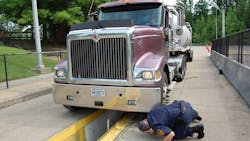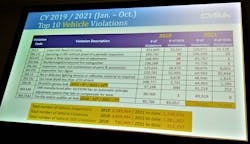OOS ‘dis-order’: Inspectors aren’t perfect, but bulk carriers aren’t powerless
Knowledge is power.
But acquiring knowledge, as a real American hero (G.I. Joe, of course) once told us, is only half the battle. Armed with the right information, bulk carriers can present a more powerful case to the Federal Motor Carrier Safety Administration when they have a valid concern about data collected during a roadside inspection.
That fleet-friendly weapon is the DataQ—the tool motor carriers can use to challenge violations that adversely affect their Compliance, Safety, Accountability (CSA) scores, and lead to costly out-of-service orders.
To help prep tank fleets for battle, National Tank Truck Carriers enlisted an inspections expert.
Kerri Wirachowsky, director of roadside inspections for the Commercial Vehicle Safety Alliance (CVSA), guided the maintenance-related sessions at NTTC’s 2021 Tank Truck Week in Dallas, Texas. During the first two sessions, the former Canadian patrol officer provided an overview of CVSA, including what it is and isn’t, and how its committees and programs aid commercial motor vehicle operators; and shared some of the most common vehicle violations—and which ones shouldn’t put vehicles out of service.
“Inspectors are far from perfect,” Wirachowsky acknowledged. “Industry isn’t perfect either … (but) if you’re done wrong, you need to know. Knowledge is power, and if you know that something was done wrong—something’s on your inspection report that doesn’t belong—there are means and ways to have that taken off.
“You can file DataQs, but if you file a DataQ, and you’re just throwing something against the wall and hoping it sticks, it probably won’t.”
CVSA 101
CVSA is a non-profit association. It is not a government agency, so it doesn’t write or enforce federal motor vehicle safety regulations. But it is an alliance comprised of local, state, provincial, territorial, and federal commercial vehicle safety officials and industry representatives—who all hold a stake in transportation safety.
It’s also a wealth of information and equally valuable connections.
Their stated mission is to improve commercial vehicle safety and uniformity throughout Canada, Mexico, and the United States by providing guidance and education to enforcement, industry, and policy makers.
Key CVSA functions include developing and maintaining the North American Standard Out-of-Service Criteria, certifying law enforcement officers to conduct roadside inspections, and awarding the valuable decals that tell inspectors a vehicle already passed a 37-step Level I inspection without any critical vehicle inspection violations.
And one of the biggest benefits of CVSA membership, Wirachowsky asserted, is access to up-to-date operational policies and inspection procedures, including Policy 15, which provides insight on when an inspector should cite a violation. “If you don’t know that information, then maybe you get a violation on your inspection report that doesn’t belong,” she said. “For example, there’s one in there to tell inspectors not to write up underinflated tires until they’re 50% or less of the sidewall rating of the tire. But I still see underinflation in the (violation) data, which means some inspectors aren’t reading the policy, or they’re going against the policy; and what it really tells me is there is a bunch of industry out there that doesn’t know that’s the guidance, and they don’t know enough to DataQ it off their inspection report.”
Out-of-service criteria
The North American Standard Out-of-Service Criteria handbook spells out the pass-fail criteria inspectors use to identify critical safety violations that sideline drivers, vehicles, and/or cargo until the conditions or defects are corrected or fixed. The handbook—divided into four parts covering driver, vehicle, hazardous materials/dangerous goods, and administrative out-of-service criteria; and available in multiple languages and formats—is not a maintenance or performance standard, or a collection of federal regulations.
“I get calls from people asking, ‘Why was I written up for an ABS malfunction lamp because I can’t find it in your book?’ Well, that’s because you’ll never be placed out of service for an ABS lamp. That’s why it’s not in my book. But you know what, it’s in the other book—the federal regulations—and that’s the book that you need to maintain your truck to. But if you wait to meet that book, you’re going to be in trouble.”
CVSA now also offers an Out-of-Service Criteria app for Android and Apple users.
Inspection decals
Certified inspectors are supposed to award CVSA decals for vehicles without any violations of the 16 critical items outlined in the out-of-service criteria, but that doesn’t always happen, Wirachowsky said. If a driver is familiar with the criteria, they’re more likely to secure a decal that’s due before returning to the road.
Critical vehicle inspection items include brake systems; cargo securement; coupling devices; driveline/driveshaft; driver’s seat (missing); exhaust systems; frames; fuel systems; lighting devices (turn signals, brake/tail/head lamps, lamps on projecting loads); steering mechanisms; suspensions; tires; wheels, rims and hubs; and windshield wipers.
The decals are good for up to 90 days (the month affixed, plus two more). They’re color- and corner-coded so inspectors can easily identify the year and month issued, and whether or not another inspection is warranted.
Committees
CVSA has 10 committees. The most pertinent ones for bulk haulers include the Associate Advisory Committee, the Driver-Traffic Enforcement Committee, the Hazardous Materials Committee, and the Vehicle Committee, which Wirachowsky chaired for 10 years. “The Vehicle Committee is responsible for all of the out-of-service criteria for vehicle components,” she said. “So when your truck is inspected at roadside, if you’re put out of service for anything vehicle-related, that’s the committee that develops those criteria.”
The Advisory committee, which is CVSA’s largest, is open to any law enforcement or transportation industry member, who can provide feedback on potential new criteria and influence what goes into the handbook. The Enforcement committee deals in everything related to Part I of the handbook, the hazmat committee develops Part III criteria, and the Vehicle committee updates and clarifies Part II.
CVSA leverages the technical expertise of carriers represented on the Hazardous Materials committee to develop criteria that reduces incidents and encourages uniformity in the transportation of hazmat cargoes. Committee members provide the board of directors with updates on issues that include shipping papers, placarding, bulk packages/large means of containment, transport vehicle markings, poison inhalation hazard markings, non-bulk packaging/small means of containment, loading and securement, forbidden materials, radioactive materials (radiation levels), and emergency response assistance plans in Canada.
Programs
CVSA programs include International Road Check, a 72-hour enforcement and education blitz this year scheduled for May 17-19; Operation Safe Driver, slated to run July 10-16; and Operation Airbrake, which includes Brake Safety Week Aug. 21-27, and a one-day, brake-safety initiative that isn’t revealed in advance.
A critical one for bulk haulers is the Cooperative Hazardous Materials Enforcement Development (COHMED) Program, which presents the annual COHMED Conference. This year’s event was held Jan. 24-28 in San Diego, Calif. The conference is a “can’t-miss” for anyone involved in hazmat regulation, transportation, enforcement, and safety.
“A lot of roadside guys are really good at checking a truck, but not a lot of guys are really knowledgeable on hazardous materials,” Wirachowsky said. “It’s not easy, so hazardous materials is something a lot of enforcement folks shy away from, because if they’re not good at it, and not confident with it, they tend to back away.
“It’s also something you lose if you don’t do it all the time.”
The association also offers roadside inspection courses for transportation industry members. The trainings, typically held at state trucking association offices, are divided into two courses covering driver and vehicle requirements.
Visit cvsa.org for more information on CVSA committees, programs, and events, along with other valuable resources like inspection bulletins categorized by topic, inspection procedures, a listing of all active FMCSA exemptions—which can be downloaded and kept on hand for inspectors—and emergency declarations.
International Roadcheck
More than 40,000 commercial motor vehicle inspections were conducted last May as part of CVSA’s 2021 International Roadcheck.
Approximately 83.5% of the commercial motor vehicles examined had no out-of-service (OOS) violations, and CVSA placed decals on 9,951 power units and 3,795 trailers that passed Level I or V inspections (there are eight levels in the North American Standard Inspection Program) with no critical vehicle inspection item violations.
However, inspectors removed 6,710 total commercial vehicles and 2,080 drivers from roadways—a 16.5% vehicle and 5.3% driver out-of-service rate—after the discovery of out-of-service violations during Roadcheck inspections. And inspectors who performed Level I inspections removed 5,048 vehicles (21.8%) from service.
But Wirachowsky said some of those OOS orders were incorrect.
Out-of-service dis-order
A focus of last year’s Roadcheck was lighting, which accounted for 14.1% (1,367) of all vehicle out-of-service violations. And, overall, through the first 10 months of 2021, inspectors issued 228,571 violations for inoperable required lamps (49 CFR 393.9)—which included 16,138 out-of-service violations that shouldn’t exist.
“I should have zero out-of-services,” Wirachowsky said.
“You should never be placed out of service for an ID light, clearance light, side marker light, license plate light, or reflective tape—ever, ever, ever. So what this tells me is, either inspectors are not citing the right violation—so they had a turn signal that was out, but they cited the general category, instead of drilling it down to a turn signal, brake light, or taillight—or they put somebody out of service for a clearance light, which is not right.”
LED lamps with non-functioning diodes technically are operable, as long as they are visible from 500 feet. But CVSA’s current guidance is subjective, Wirachowsky said, so she recommends replacing defective diodes as soon as possible.
Other common vehicle violations from 2019 and 2021 (Wirachowsky excluded pandemic-skewed 2020 data) include operating a commercial vehicle without proof of a periodic inspection; clamp or roto-type brakes out of adjustment; inspection, repair, and maintenance of parts and accessories; inoperative turn signals; tread depth less than 2/32 of an inch; and oil and/or grease leaks.
But, again, not all of these violations are supposed to render a vehicle out of service.
In 2019, 32 vehicles were placed out of service for operating without proof of an annual inspection, which isn’t an out-of-service condition, Wirachowsky said. Similarly, she said, vehicles never should be sidelined for a brake-adjustment violation—yet 26 vehicles were in 2019 (when 168,304 393.47E violations were issued).
“If you have a brake out of adjustment on an axle, and that’s all you have, you’ll be cited for 393.47E,” Wirachowsky said. “That’s the violation. You’re not out of service, though, unless you have another brake with something wrong. So if you have a contaminated lining, another brake out of adjustment, no linings on a wheel—whatever the case may be—now, if it’s a five-axle combination, those two violations together place the vehicle out of service. But they don’t place the vehicle out of service under the adjustment number.
“They place the vehicle out of service under the 396.3A1BOS combination out of service (20% of more of total brakes are defective).”
Duals should not be put out of service unless both tires in the set have less than 2/32 inches of tread depth, and oil and gas leaks are not violations until the inspector sees a drop hit the roadway during an inspection.
A handful of vehicles also were incorrectly parked for fire-extinguisher issues.
“I got a call one time because someone got cited because their fire extinguisher wasn’t standing up,” Wirachowsky said. “There’s nothing in the regulation that says the fire extinguisher has to be standing up. Most of them aren’t standing up. They have to be secure, they have to be charged, they have to be there—that’s it.
“So if you get cited for something that doesn’t sound right, it’s probably not.”
DataQs defense
Sometimes incorrect FMCSA data is attributable to a simple mistake.
It’s not uncommon for an inspector to enter the U.S. Department of Transportation number from a leased truck, instead of the carrier’s USDOT number—or for a carrier to forget to remove a decal from a truck he bought from someone else. And like everyone, inspectors can be guilty of “fat fingers” while typing, or simply inputting data too quickly. “Those types of issues are commonplace,” Wirachowsky said.
Another common source of confusion is Violation 396.3A1, failure to inspect, repair, and maintain parts and accessories. Inspectors use it as a catch-all for items not found in Part 393, like driveshaft issues, broken wheel hubs, and loose air tanks. But they’re only supposed to cite the violation when placing a vehicle out of service, and that’s not always the case, so total violations don’t match OOS violations.
Wirachowsky said she expects FMCSA to soon address the issue by approving CVSA’s petition to amend 393 with new maintenance items. “Please don’t panic,” she said. “It doesn’t change a blessed thing as to what you have to do with your truck.”
Whatever the case, DataQs is a valuable instrument—for those who know how to wield it.
The online system was created for commercial drivers and motor carriers to submit concerns regarding publicly available state and federal data. It’s commonly used to dispute violation errors or inspection reports operators feel are inaccurate, and may reflect poorly on their CSA score; and to request reports.
To use the system, visit dataqs.fmcsa.dot.gov. New users can click on “New to DataQs” for complete registration instructions. Once an account is established, users receive additional information typically not made public. Account validation requires the PIN issued by FMCSA when the user’s USDOT number was registered.
About the Author
Jason McDaniel
Jason McDaniel, based in the Houston TX area, has more than 20 years of experience as an award-winning journalist. He spent 15 writing and editing for daily newspapers, including the Houston Chronicle, and began covering the commercial vehicle industry in 2018. He was named editor of Bulk Transporter and Refrigerated Transporter magazines in July 2020.




